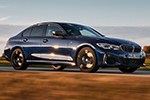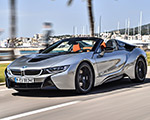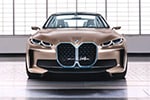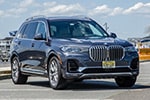Ever since the new M5 debuted a year ago, nearly every discussion has centered on its curb weight. At 2,435 kilograms in European specification, the sports sedan is 540 kg heavier than the M5 Competition (F90) it replaces. In the United States, the G90 tips the scales at 5,390 pounds, an increase of 1,045 lbs over its predecessor. The main contributor to this added heft is the plug-in hybrid system. But why did BMW decide to rock down to electric avenue?
Speaking at the 2025 Concorso d’Eleganza Villa d’Este over the weekend, M boss Frank van Meel explained the reasoning behind making the seventh-generation M5 a PHEV. First and foremost, it relates to the steep taxes imposed on high-emission vehicles in Europe. Once all regional fees were factored in, the M5 would have been even more expensive without the plug-in hybrid system.
By incorporating an electric motor and battery pack, BMW significantly lowered the car’s CO₂ emissions, reducing the pricing penalty typically associated with thirsty combustion engines. For a striking comparison: in Ireland, the M3 is actually more expensive than the M5. As strange as that may sound, a G80 Competition xDrive starts at €154,395, while its larger sibling comes in at “only” €137,045. That means the M5, a car from a superior segment, is €17,350 cheaper.
But the plug-in hybrid isn’t just about making the M5 more price-competitive in the European Union. Van Meel also defended the inclusion of an 18.6-kWh battery, which gives the car a decent electric-only range of up to 69 kilometers on the WLTP cycle. The EPA has rated the car at 27 miles of EV range in the United States.
The electric motor produces 197 horsepower, making the M5 “easy to drive in town,” according to van Meel. He added that electrification also reduces fuel consumption, benefiting the environment. While he acknowledged the added weight that comes with these improvements, van Meel remains confident that the new G90 is quicker than the beloved F90 it replaces.
“The only trade off was, if you combine the V8 with plug in, you add a lot of weight. And for us, that was like in racing and the balance of performance. If your car is too quick, you get punished by getting more weight into the car. What you do when you get more weight in the car is you try to get back into the window of performance. And that’s something you do by chassis setup. We widened the track. So that’s why the M5 has a wide body now for the first time.”
The mayor of M Town explained that placing the battery at the lowest point possible reduced body roll. Combined with revised suspension, wider tracks, and rear-wheel steering, these measures help offset the extra mass. These changes ensure the M5 delivers the performance expected of an M car, now with the added benefits of electrification.






































































